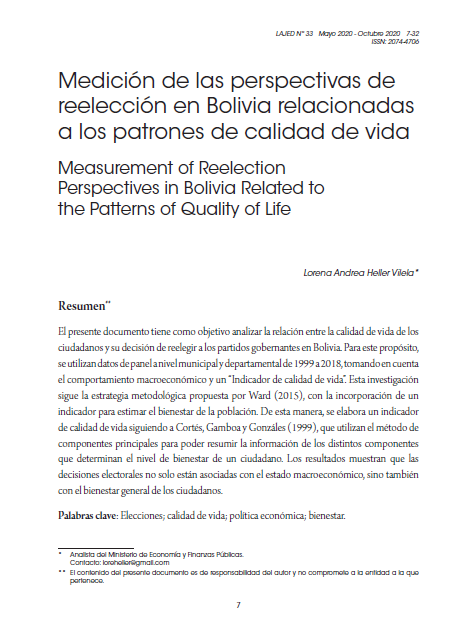Measurement of Reelection Perspectives in Bolivia Related to the Patterns of Quality of Life
DOI:
https://doi.org/10.35319/lajed.202033414Keywords:
Elections, Quality of Life, Political Economy, Well-beingAbstract
The purpose of this document is to analyze the relationship between citizens’ quality of life and their decision to re-elect the ruling parties in Bolivia. For this purpose, a panel data is used at municipal and departmental level from 1999 to 2018, taking into account macroeconomic behavior and a Quality of Life Indicator. ftis research follows the methodological strategy proposed by Ward (2015), with the inclusion of an indicator to estimate the well-being of the population. fterefore, a Quality of Life Indicator is developed following Cortés, Gamboa and Gonzáles (1999), who use the principal components method to summarize the information of the different components that determine the level of well-being of a citizen. fte results demonstrate that electoral decisions are not only associated to macroeconomic state but also to the general welfare of citizens.
Downloads
References
Acosta, O; Guerra J. y Rivera, D. (2005). Acceso de los hogares a los principales servicios públicos y sociales y percepciones de calidad sobre estos servicios. Serie Documentos, Borradores de investigación Nº 76, Universidad del Rosario.
Alesina, A. y Rosenthal, H. (1995). Partisan Politics, Divided Government and the Economy. Cambridge University Press.
Barro, R. J. (1973). fte control of politicians: An economic model. Public Choice, 14, 19- 42.
Besley, T.; Kudamatsu, M.; Merlo, A.; Olken, B. y Nunn, N. (2006). “Health and Democracy”. American Economic Review, 96(2), 313-318.
Bloom, H. y Price, H.D. (1975). Voter Response to Short-Run Economic Conditions: the Asymmetric Effect of Prosperity and Recession. American Political Science Review, 69(4), 1240-1254.
Castaño, E. y Moreno, H. (1994). Selección y cuantificación de variables del sistema de selección de beneficiarios, SISBEN. Planeación y Desarrollo, 25, 259-283.
Cortés, D.; Gamboa, L. y González, J. (1999). ICV: hacia una medida estándar de vida. Coyuntura Social, 264, 160-180.
Di Tella, R.; MacCulloch, R. J. y Oswald, A. J. (2003). fte macroeconomics of happiness. Review of Economics and Statistics, 85(4), 809-827.
Dolan, P.; Metcalfe, R. y Powdthavee, N. (2008). Electing happiness: does happiness effect voting and do elections affect happiness. Discussion Papers in Economics Nº 2008/30.
Downs, A. (1957). An Economic fteory of Political Action in a Democracy. Journal of Political Economy, 65(2), 135-150.
Fair, R. C. (1996). Econometrics and Presidential Elections. Journal of Economic Perspectives, 10(3), 89-102.
Ferejohn, J. (1986). Incumbent Performance and Electoral Control. Public Choice, 50(1/3), 5-25.
Flavin, P. y Keane, M. J. (2012). Life Satisfaction and Political Participation: Evidence from the United States. Journal of Happiness Studies,13(1), 63-78.
Frey, B. y Stutzer, A. (2006). Environmental Morale and Motivation. Recuperado de SSRN: https://ssrn.com/abstract=900370.
Helliwell, J. F.; Huang, H. y Wang, S. (2014). Social Capital and Well-Being in Times of Crisis. Journal of Happiness Studies, 15(1), 145-162.
Hibbs Jr., D. A. (2000). Bread and Peace Voting in U.S. Presidential Elections. Public Choice, 104(1/2), 149-180.
Kramer, G. H. (1971). Short-Term Fluctuations in U.S. Voting Behavior, 1896-1964. The American Political Science Review, 65(1), 131-143.
Lächler, U. (1984). fte political business cycle under rational voting behavior. Public Choice, 44(3), 411-430.
Mueller, S. y Dardanelli, P. (2013). fte parliamentary and executive elections in Switzerland. Electoral Studies, 32(1), 197-201.
Ocampo, M. y Foronda Rojas, C. A. (2007). Estudio de la calidad de vida en Bolivia: metodología y medición. Investigación y Desarrollo, 1(7), 24-38.
Okun, D. A. (1981). Deteriorating sources deserve concern. Journal American Water Works Association, 73(6), 14-14.
Persson, T. y Tabellini, G. (1994). Representative democracy and capital taxation. Journal of Public Economics, 55(1), 53-70.
Riker, W. H. y Ordeshook, P.C. (1968). A fteory of the Calculus of Voting. The American Political Science Review, 65(1), 25-42.
Rogoff, K. y Sibert, A. (1988). Elections and Macroeconomic Policy Cycles. The Review of Economic Studies, 55(1), 1-16.
Sen, A. (1976). Elección colectiva y bienestar social. Madrid: Alianza.
---------- (1985). Well-Being, Agency and Freedom. The Journal of Philosophy, 82(4), 169-221.
---------- (1997). Maximization and the Act of Choice. Econometrica, 65(4), 745-779.
Stevenson, B. y Wolfers, J. (2008). Economic Growth and Subjective Well-Being: Reassessing the Easterlin Paradox. NBER, Working Paper Nº 14282.
Stigler, G. J. (1973). General Economic Conditions and National Elections. American Economic Review, 63(2), 160-167.
Tullock, G. (1967). fte Welfare Costs of Tariffs, Monopolies, and fteft. Economic Inquiry, 5(3), 224-232.
Ward, G. (2015). Is happiness a predictor of election results?. CEP Discussion Paper Nº 1343.






